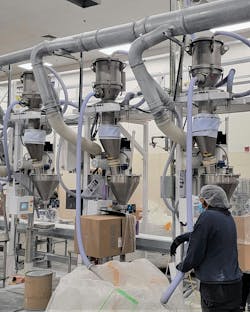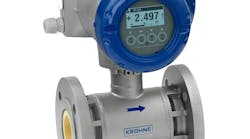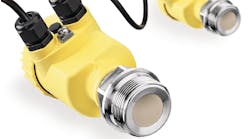Vacuum Conveying Moves the Meter on Safety and Efficiency
Vacuum conveying systems automate the movement of dry materials, offering numerous benefits in industrial processes. They improve safety by controlling dust, reducing spills and handling combustible powders more securely than pressure-conveying systems. These systems enhance quality control through consistent ingredient ratios and efficient packaging, which is crucial for consumer brand management and avoiding costly recalls.
However, there are considerations to factor in when selecting a system. To discuss the challenges and benefits of vacuum-conveying, Chemical Processing sat down with David Kennedy, business development manager at VAC-U-MAX. The following is an edited version of that conversation.
Q: How does vacuum conveying automate processes?
A. Automation mechanizes some processes that were previously done manually. Vacuum conveying systems improve dust control, which has many safety benefits. They use suction to move dry materials around. If they leak, they leak inward. Compared to a pressure-conveying system, they don't cause any dust problems.
All the filters are internal, which means it's good for the plant environment and the worker environment as well. Many powders are not good from a respirable standpoint and from a combustibility standpoint.
They reduce the chances of spills, which is good for productivity and safety. They allow better quality control; when you convey ingredients by vacuum, it's more repeatable and predictable than a manual process. They allow you to get involved in technologies such as batch weighing, where you have recipes and can maintain the correct ratios of one ingredient versus another.
It is great for the packaging industry, where many products these days are powders packaged in anything from sugar packets and stick packs to 50-pound bags or even 2000-pound bulk bags. So vacuum conveying is a very efficient way of moving powders.
When it comes to consumer brand management, companies don't want recalls, which are very expensive. They also don't want packages that are incorrectly weighed or poorly mixed. Quality is a very expensive area to make a mistake in or not take as seriously as possible.
Q: What about some of the safety features that are essential in vacuum conveying systems?
A: Any company that's handling a powder or a dry material that is already a powder or has the potential to become a powder in the process has a legal responsibility to comply with regulations that are enforced by OSHA. OSHA relies on standards that are promulgated by the National Fire Protection Association (NFPA), as well as Factory Mutual.
Companies are obligated to follow those standards to provide workers with a safe environment and to ensure ongoing operations. Many products are combustible in their natural form or in their processed form. Some people grind up the materials to get the powder. They're creating dust that can potentially be combustible, and vacuum conveying is well suited to move those combustible powders.
In fact, NFPA refers to it as the preferred technology for moving bulk combustible powders because of a reason I mentioned before, which is if it leaks, it leaks inward. Other alternative technologies like pressure conveying where you're blowing the material from point A to point B, if there is a leak, in very short order, you will have a cloud or a pile of that combustible material on surfaces where you don't want them. Vacuum conveying helps achieve compliance with combustible dust standards.
Q: Let’s talk about challenges with powder handling and how to overcome them.
A: The first thing we look at when we evaluate a project is the flowability of the material. Some materials are free-flowing (sugar is an example). But you have other non-free-flowing materials, meaning you could open the discharge, and nothing will come out, or very little will come out or will come out too slow for your process. And then there are materials that will come out too fast.
We must look at the powder characteristics or the dry material characteristics closely to determine whether we need to give them some help to flow or whether we need to hold them back because they flow like water. It is quite a science. It really is an experience factor because one customer will say they're handling a powder in their factory in New Jersey, but they're also handling it in California or Florida, where they have different plant conditions. And the next thing you know that same material flows differently in those different locations.
Q: VAC-U-Max has a technology that allows you to clean and replace filters by bringing it down to the operator at ground level. Can you talk a little bit about that?
A: Some vacuum technology has not changed over the years. Experience is still the first thing that we sell to our customers about all the 10,000 types of materials that we've conveyed. But what has changed is the operator friendliness or the maintenance friendliness that companies need these days. Downtime is a very expensive factor. A good plant manager will recognize the cost of downtime.
We've designed products—one is a Columnlift™, and the other is a mobile conveyor that allows you to bring those vacuum receivers down to ground level. This is always going to be a better maintenance and sanitation position than trying to clean or maintain the equipment when it's six feet or even 25 feet up in the air.
It is a valuable, simple tool, but the equipment needs to be able to work in an industrial environment, which occasionally has special electrical requirements and structural requirements, not to mention footprint requirements. Anything that saves on the footprint of your equipment is also valuable. The Columnlift™ and the mobile conveyor both can eliminate the need for a mezzanine.
A piece of equipment that might only be two feet square might require a mezzanine or a service platform that's six or eight feet square. So now you're saving a lot of footprint and valuable floor space by using an elevating device like our Columnlift™. And of course, the workers don't have to climb the stairs again or use ladders to get up there.
Q: Let's talk a little bit about maintenance practices.
A: All vacuum conveying equipment has some form of a filter to separate powder from the air stream. I like to refer to the filters as the lungs of a conveying system, and you need to maintain those filters. Part of our engineering efforts have been to make filter access and filter maintenance easy. When you put the equipment up at an elevated position, it's very easy to say, not today; I can't access my scissor lift, today's just not a good day. There are a lot of excuses for not maintaining equipment.
We work hard to make filter changing easy, fast and clean. Some of our designs now allow the operator to remove and change the filters from what we call the clean side, meaning you're in the ambient air of the plant, rather than the air inside of a vacuum receiver. Our designs are helping to avoid confined space requirements.
If maintenance needs to operate or go inside a piece of equipment, they must address confined space, which becomes very costly because now, instead of one operator worker, you need two or three. They need to monitor oxygen levels; they must have spotters. Depending on how big the equipment is, it can really blow the maintenance operation out of proportion.
We work hard in our engineering department to make our equipment easy to service and fast to service.
Q: How can vacuum conveying increase a company's bottom line?
A: In some companies, the safety manager is a very important position. They'll be on the lookout for hazardous working conditions, and we'll solve their health problems by reducing dust using vacuum technology. We have customers who handle dusts or powders that should not be respirable, meaning they are health hazards.
Your alternative to doing vacuum conveying is fitting operators with respirators. It's an expensive process by itself, but it's very unpopular with workers. My favorite story is about factories that are in big hunting areas where hunting season comes along and the men are growing beards, and you can't wear a respirator if you've got a beard.
Additionally, some of the materials are eye irritants, nose irritants or skin irritants. Taking the operator away from that exposure coupled with the ergonomics -- the cost of a lower back injury is easily in the six figures. I am not talking about just workers’ comp but about the indirect costs of having to hire replacement labor or to move people around and lost productivity.
And then there’s the quality aspect. Sometimes the benefits that we offer are like an insurance policy. You really hope you never have to deal with it. But we will help people protect themselves against future injury or recalls, which not only are expensive but they are also hurtful to a brand.
Q: Is there anything you want to add?
A: I think that a lot of the customers are interested in retaining workers, not just replacing them. Some customers come to us after the fact, after they've had an injury, a major spill or a recall, and that horse is out of the barn. We like to encourage customers to think ahead, and we'll help them with their justification.
For more information, visit: https://www.vac-u-max.com/






